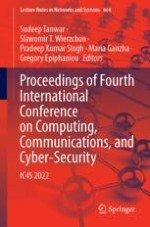2023 | Buch
Proceedings of Fourth International Conference on Computing, Communications, and Cyber-Security
IC4S 2022
herausgegeben von: Sudeep Tanwar, Slawomir T. Wierzchon, Pradeep Kumar Singh, Maria Ganzha, Gregory Epiphaniou
Verlag: Springer Nature Singapore
Buchreihe : Lecture Notes in Networks and Systems
